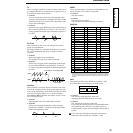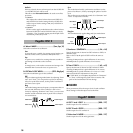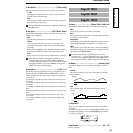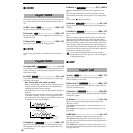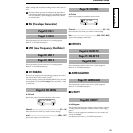
Parameter Guide
45
D: HiEQGain.........................................[–12.0...+12.0]
Set the gain of the high-range equalizer.
Excessively raising the equalizer gain parameters may
cause the output to be distorted.
■ ARPEGGIATOR
These are the arpeggiator-related parameters.
ON/OFF...................................................... [ON, OFF]
Turn the arpeggiator on/off.
This parameter can be set only by the front panel key. When
this is ON, the key LED will light.
LATCH ......................................................... [ON, OFF]
Specify how the arpeggiator will operate when you take
your hand off of the keyboard.
This parameter can be set only by the front panel key.
If this is ON (the key LED will light), the arpeggiator will
continue playing even if you take your hand off of the key-
board.
If this is OFF (the key LED will go dark), the arpeggiator will
stop playing when you take your hand off of the keyboard.
A: Type ❮ TYPE ❯ ......................................[Up...Trigger]
Select the arpeggio type.
Up
Notes will be played consecutively from low to high
pitches.
Down
Notes will be played consecutively from high to low
pitches.
Alt 1
Up and Down will be alternated. (The highest and lowest
notes will be sounded once.)
Alt 2
Up and Down will be alternated. (The highest and lowest
notes will be sounded twice.)
Random
Notes will be played randomly.
Trigger
The notes that you are actually pressing will be sounded at
intervals of the trigger. The trigger timing is determined
by the “Tempo” setting.
The “Range” setting will be ignored.
If a greater number of keys are played than the number
of timbres specified in Page 01B: COMMON “Timbre
Voice” or Page 03A: VOICE “Assign,” notes will be
played starting at the lowest-pitched note and continu-
ing upward for the maximum number of allowable
notes.
B: Range ❮ RANGE ❯....................[1 Octave...4 Octave]
Specify the octave range in which the arpeggio will be
played.
With a setting of 1 Octave, the arpeggio will be played in a
range of 1 octave.
With a setting of 2 Octave, the arpeggio will be played in a
range of 2 octaves.
With a setting of 3 Octave, the arpeggio will be played in a
range of 3 octaves.
With a setting of 4 Octave, the arpeggio will be played in a
range of 4 octaves.
C: Tempo ❮ TEMPO ❯.....................................[20...300]
Specify the tempo of the arpeggio.
Increasing this value will speed up the arpeggio tempo.
If the Global mode Page 3C: MIDI “Clock” setting is
External, this setting will be ignored.
This setting will also be the sequence playback speed.
D: Gate Time ❮ GATE ❯...........................[000%...100%]
Specify the note length (gate time) of the arpeggiated notes.
With a setting of 000, each note will be extremely short.
With set to 100, each note will continue playing until the next
note is triggerd.
E: Target.............................................[Both...Timbre 2]
Select the timbre(s) that will be played by the arpeggiator.
This parameter will be displayed and can be set only if Page
01A: COMMON “Mode” is set to Dual/Split.
Both
Both timbres will be sounded by the arpeggiator.
Timbre 1
Only timbre 1 will be sounded by the arpeggiator.
Timbre 2
Only timbre 2 will be sounded by the arpeggiator.
The MIDI channel of the timbre(s) to be sounded by
the arpeggiator must be set to the Global MIDI chan-
nel. If the timbre is set to other than the Global MIDI
channel, it cannot be sounded by the arpeggiator.
Page25: ARPEGGIO
Program parameters



